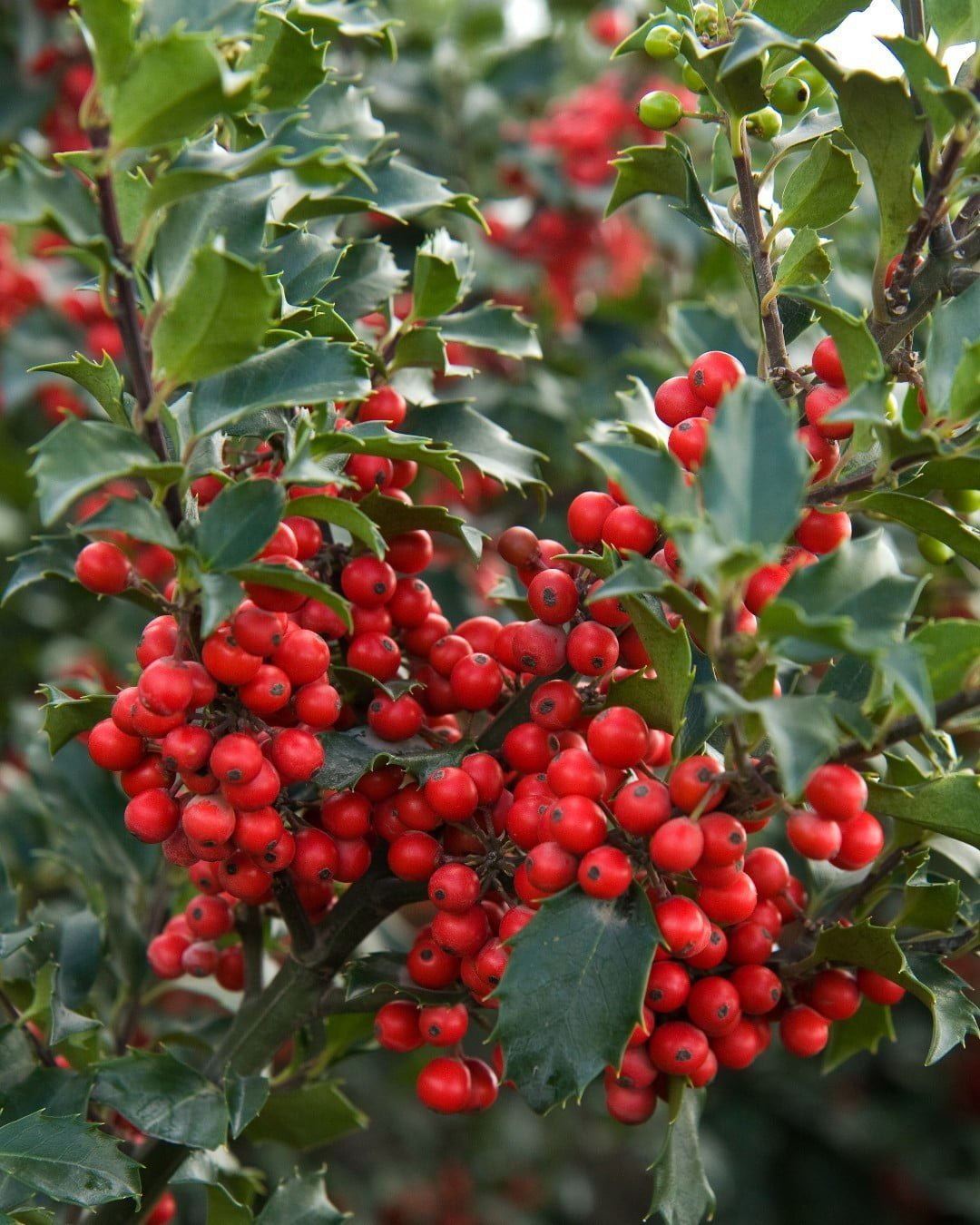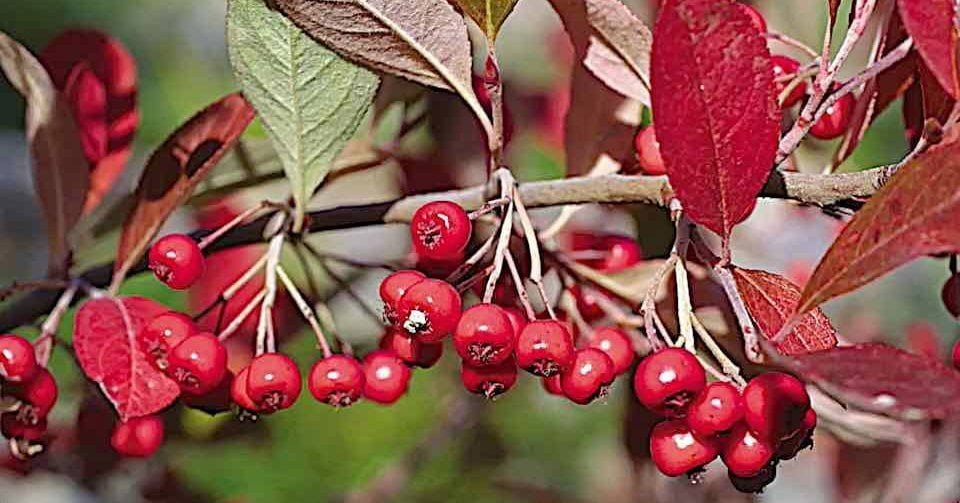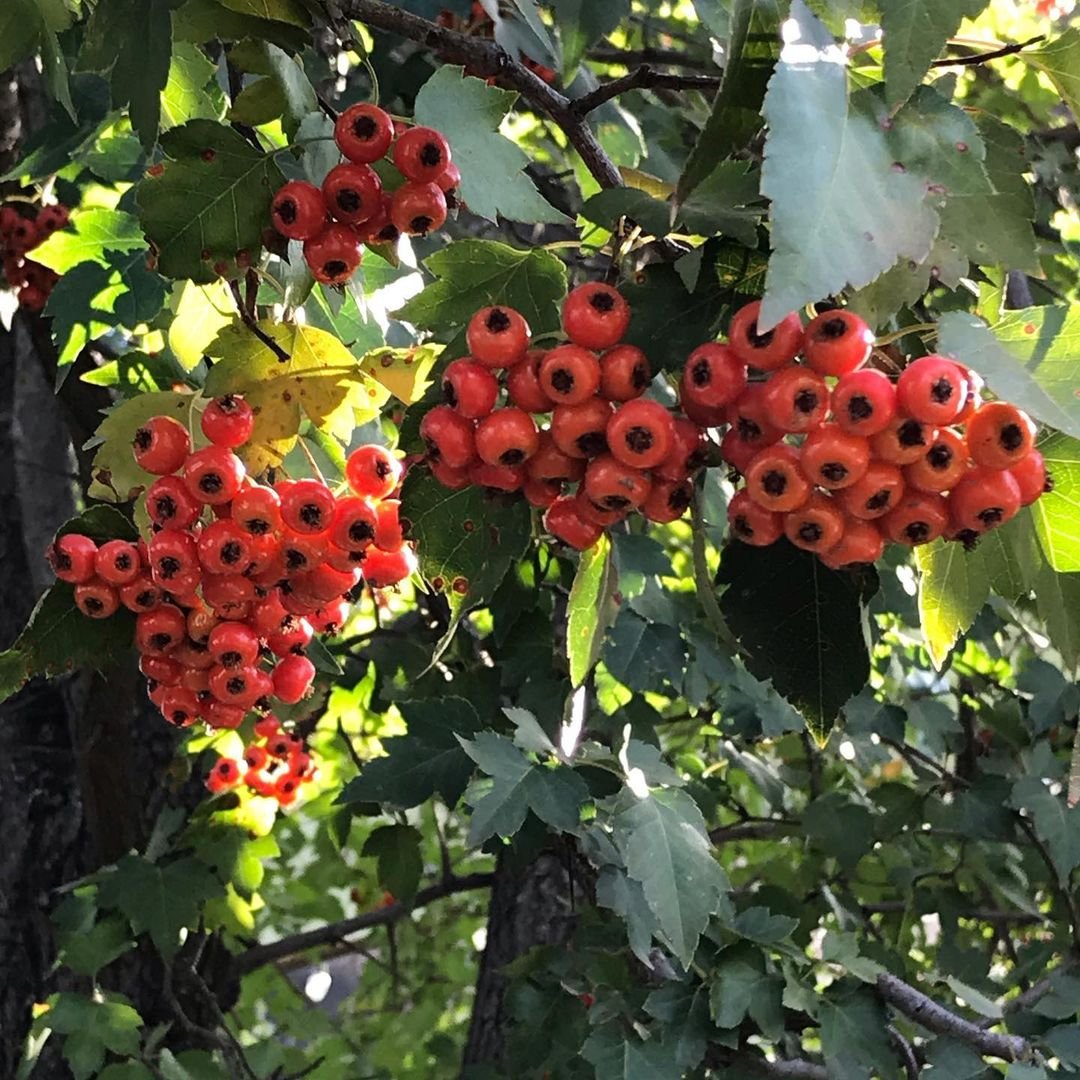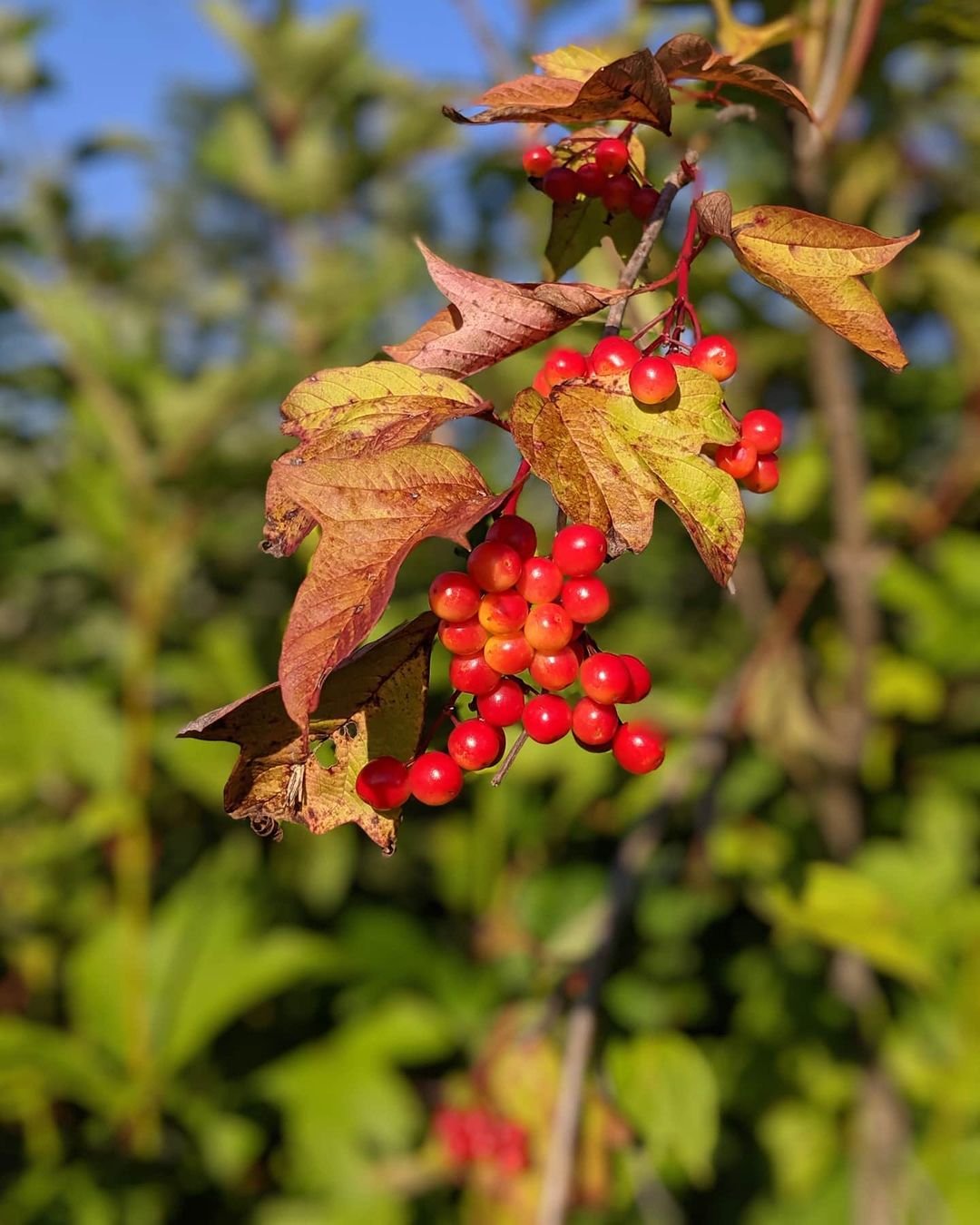Nothing brightens up a winter landscape like the cheerful pop of red berries amidst bare branches. Many trees and shrubs produce these vibrant gems that persist through the cold months, providing color, food for wildlife, and holiday decor. Let’s explore some stunning red-berried plants perfect for American gardens.
Hollies

Hollies are a classic choice for red berry production, and a garden staple across the US. With their signature prickly leaves and bright berries, they’re ideal for hedges, accent plants or specimen trees.
Key Details:
- Many varieties available in various sizes from 3-50 feet tall
- Require both male and female plants to get berries
- Thrive in full sun to partial shade
- Berries attract songbirds like robins, cedar waxwings and mockingbirds
I’m a huge fan of hollies for their festive winter berries and traditional look. They make wonderful hedges that can be sheared into tidy shapes or left to grow naturally into sculptural forms. The Nellie R. Stevens is a popular cultivar that’s a heavy berry producer. For tree forms, try the Yaupon or East Palatka hollies. Just be sure to plant at least one male for pollination if you want those glorious berries. Established hollies handle pruning well if you need to reign them in.
Winterberry

An outstanding native shrub, winterberry dazzles with loads of brightvred berries that last into early spring. It makes a striking display in mass plantings or hedges.
Key Details:
- Grows 6-12 feet tall and wide
- Requires male pollinator for berries
- Best with consistent moisture
- Berries are consumed by many bird species including cedar waxwings
Winterberry is one of my top picks for reliable red berries since it holds them for so long. These bushy shrubs have a pleasingly rounded shape and put on a spectacular show when loaded up. My advice is to plan for a male pollinator within 50 feet, plant in a full sun area with moist, acidic soil, and apply mulch to conserve moisture. Once established, winterberries have few pest issues and provide wonderful winter interest and food for wildlife. I love using cuttings indoors as well.
Pyracantha (Firethorn)

Firethorns earn their name with a smoldering display of long-lasting red-orange berries borne along thorny branches. They easily trained into hedges or espaliers.
Key Details:
- Grow 6-16 feet tall depending on variety
- Sharp thorns make them a good barrier plant
- Full sun exposure produces most abundant berries
- Birds, especially robins and cedar waxwings, relish the berries
For sheer profusion of berries, pyracanthas are hard to beat. Just be very careful when pruning – those thorns mean business! I always use protective gloves and tend to them in early spring before new growth emerges. Despite their ferocious bark, pyracanthas can be tamed into beautiful hedges, small trees, or trained espaliers. Left un-pruned, they’ll naturally grow into a dense tangle. Plant in full sun and well-drained soil for best fruiting. One mature plant can produce thousands of berries that persist for many months.
Red Chokeberry

A four-season shrub, red chokeberry kicks off spring with white flowers, adorns itself with red berries and brilliant fall foliage, then ends with exfoliating bark.
Key Details:
- Reaches 5-9 feet tall and wide
- White spring blooms give way to clusters of red berries in late summer
- Berries make excellent jams/jellies if you beat the birds to them
- Grows well in most soils, including boggy areas
Red chokeberry is a true over-achiever in my books. Not only do the white springtime blossoms give way to beautiful red berries by late summer, you also get fantastic red fall color and peely, mottled bark adding winter interest. They have a naturally suckering, multi-stemmed habit, so I like to use them for mass plantings or mixed borders. You can keep chokeberries smaller with some selective pruning as well. The berries are quite tart for fresh eating but make wonderful jelly or wine if you can harvest before the birds strip them all off! Overall, it’s just a fuss-free, meal-of-a-plant.
Washington Hawthorn

For those seeking a beautiful small tree with persistent berries, the Washington hawthorn fits the bill. Its gnarly branches bear loads of long-lasting red pomes.
Key Details:
- Typically grows 25-30 feet tall with 20-25 foot spread
- Dense, twisted branches with thorns make a character specimen
- White spring flowers give way to plump, shiny red fruits
- Berries are bitter, but loved by birds
With its picturesque, craggy form and showy spring blooms, the Washington hawthorn makes a terrific small tree for a lawn or foundation planting. Come late summer and fall, the branches become weighted down by heavy clusters of bright red berry-like pomes. The fruits really glow in the low winter light too. Just be advised this tree has serious thorns, so take care where you site it. A few tips – choose a spot with well-drained soil and at least 6 hours of sun per day. Prune in late winter to shape as needed and remove any rubbing branches. While not for human consumption, the berries are essentially a live-in nutrient factory for birds.
American Cranberrybush

This large shrub or small tree erupts in big, vibrant clusters of cranberry-like red berries in fall that often persist through winter.
Key Details:
- Upright, vase-shaped habit reaching 8-12 feet tall and wide
- Flat-topped white spring blooms give way to vivid red berry clusters
- Berries are edible but very tart and highest in vitamin C in winter
- Plant in full sun to partial shade
For garden architecture and winter interest, the American cranberrybush is hard to beat. I’m always wowed by the huge, flat bunches of bright berries adorning its branches after the leaves drop – like nature’s own Christmas ornaments! You can count on lots of feathered visitors helping themselves too. Don’t plan on making cranberry sauce though, as the berries are extremely tart and seedy. Give this plant full sun for maximum fruiting and plenty of room to achieve its handsome, vase-like shape. While the berries may last all winter, I try to prune out any dead wood in late winter to keep it looking its best for spring’s new flush of flowers.
Beautyberry

With its clusters of vividly colored purple berries and arching branches, beautyberry adds an exotic punch of color to the landscape in fall.
Key Details:
- Fast-growing, suckering shrub reaching 3-6 feet tall
- Berries emerge bright purple and mature to darker shades
- Easily grown in most soil conditions and full to partial sun
- Birds find the berry clusters irresistible
For a real shot of late season drama, look no further than the showstopping beautyberry. When the rest of the garden is fading, this shrub bursts forth with striking clusters of neon purple berries weighing down its arched branches. It’s a wonderful accent plant and virtually maintenance free too. Just give it a hard pruning down to 6-12 inches from the ground each spring and let it regrow into its naturally fountain-like habit. Plant beautyberries in a sunny spot and watch them plump up into spectacular fall displays. While I adore their whimsical purple tones, my feathered friends seem to love them even more as a wintertime snack!
With their festive colors, wildlife appeal, and ease of care, trees and shrubs bearing red (or purple!) berries make fantastic additions to any American landscape. From hollies to hawthorns, pyracanthas to chokeberries, these plants put on a show that carries through the dullest winter days. So consider incorporating a few into your own garden spaces for year-round visual impact and the bonus of attracting songbirds too. Whether you need a tall tree centerpiece, sculptural accent plant, or colorful hedge, you’re bound to find a red-berried variety to suit your needs. I encourage you to explore these diverse options and pick the ones that will bring you the most seasonal joy.
Pingback: How to Grow & Care for Crepe Myrtle (Lagerstroemia indica) -
Pingback: How to Grow and Care for Virginia Creeper Gardeners School
Pingback: Trees and Bushes with Beautiful Red Berries | G...
Pingback: Black Currant: A Comprehensive Guide Gardeners school
Pingback: 16 Trees That Start with S -
Pingback: Complete Guide to Growing Dragon Fruit Plants at Home -
Pingback: Gooseberry Gardening: A Complete Guide to Growth and Care
Pingback: Beautiful Trees That Start With ‘R’ - Gardener's School
Pingback: Lily of the Valley Flowers: A Complete Guide
Pingback: Amazing Secrets: Trees That Start with X -
Pingback: Beautiful Trees That Start With ‘Z’ - Gardener's School
Pingback: Amazing Discoveries: Trees That Start with ‘V’
Pingback: Trees That Start with ‘I’: Discover Beautiful Nature
Pingback: Vibrant Viburnum Shrubs : A Beginner’s Guide to Growing Successfully
Pingback: Garden Design: Concepts, Ideas, and Inspiration
Pingback: Aglaonema Pictum Tricolor Care Guide Gardeners Schools
Pingback: Winter Bird Feeding: A Guide to Nourishing Our Feathered Friends